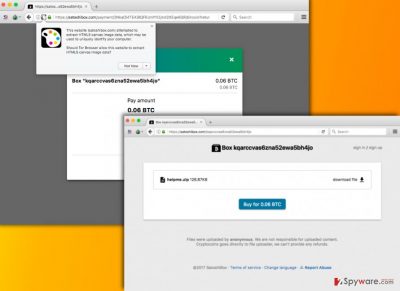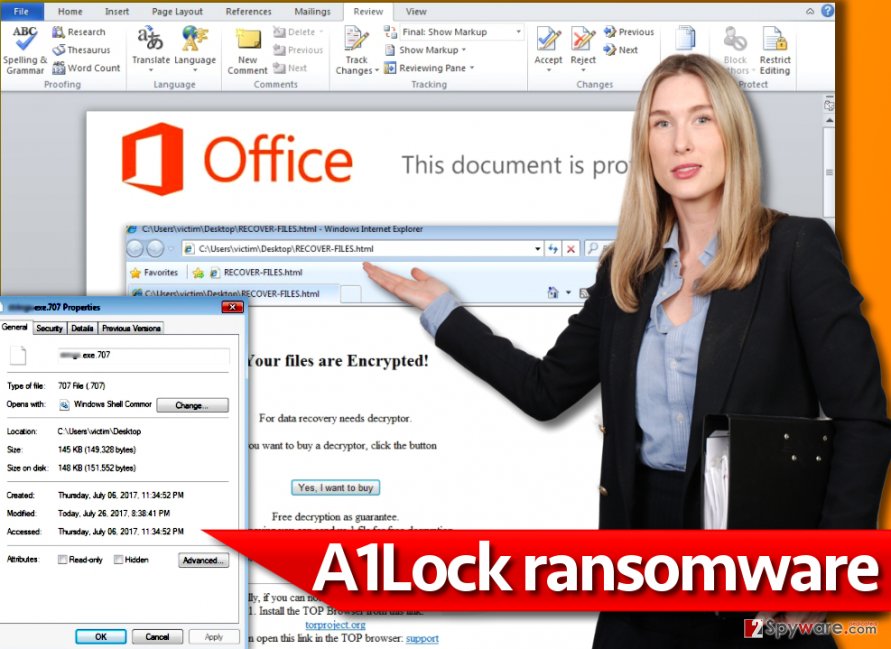A1Lock ransomware / virus (Virus Removal Instructions) - Free Guide
A1Lock virus Removal Guide
What is A1Lock ransomware virus?
A1Lock virus will encrypt your files and demand a ransom

A1Lock ransomware is a new Globe Imposter ransomware[1] version that uses .707 extension on encrypted files and creates a ransom note called RECOVER_FILES.html. The virus functions as an extortion tool that demands ransom in exchange for a data recovery software.
Once run, the malicious executable of the virus scan the entire computer system for target files. The malware has a list of file extensions that are main targets. Once the virus finds a file with a target extension, it corrupts the file using certain encryption algorithm. Once the A1Lock encrypts the file, it adds .707 extension after the original file extension to mark the file as corrupted one.
The last part of the attack involves the creation of the ransom note, also known as the file that holds data recovery instructions. The file contains victim’s personal ID and a link to a site that explains how to buy the decryptor. In order to access the website, the victim has to install a special browser called TOR.
The provided URL leads to a site that provides the helpme.zip file. The size of this file is 126.87kB. The file contains a decrypter, however, in order to access it, the victim has to pay 0.06 Bitcoin. At the moment of writing this post, the price of the decryptor was 152.22 US dollars. The ransom has to be transferred to a provided Bitcoin wallet address that collects payments from all A1Lock ransomware victims.
If you were attacked by this ransomware, we suggest you to clean your system from malicious files first. It is strongly recommended that you remove A1Lock virus ASAP. The removal can be completed using anti-malware program, and it won’t take you more than a half an hour to do it. Please, do not try to kill the virus manually because you can easily overlook some malicious files and leave the system with security vulnerabilities.
It is also important that you prepare your PC for A1Lock removal properly. To do it, we strongly recommend using instructions we made. These are given below the article.

Distribution of Globe Imposter malware
Globe Imposter viruses, including A1Lock, are mostly distributed via malspam (also known as malicious spam). Be extremely careful when opening emails sent by strangers or companies that you didn’t have any business with lately. If you suspect something strange, do not click on links or email attachments that came with the message.
Cyber criminals tend to attach .ZIP files to emails, and sometimes they protect these files with a password. In such case, the password will be listed in the message body. Do not attempt to open these archives and especially files inside of them, despite their legitimate-looking names.
Even if it sounds surprising to you, a document (Word[2] or Excel) CAN contain a virus, because it can contain a malicious script that connects to a certain domain and downloads ransomware from it.
The ransomware has already affected many computers worldwide, especially in France. If you are a citizen from this country, you might be interested in Lesvirus.fr website[3] that provides information about computer security in French language.
Remove A1Lock ransomware virus
Do not delay A1Lock removal because deleting this virus is the only available option if you want to continue using your computer safely. Typically, the ransomware hides its components from the victim; besides, it has an ability to download additional malware to the system, so you need to uninstall all malware at once ASAP. For that, we highly recommend using anti-malware software.
However, to remove A1Lock virus, you will need to make sure that it won’t attempt to interrupt you from doing so. For this reason, we strongly recommend rebooting your computer in Safe Mode with Networking and starting the removal process from there. You can find a detailed explanation of the removal procedure down below.
Getting rid of A1Lock virus. Follow these steps
Manual removal using Safe Mode
Remove the virus while in Safe Mode with Networking. Use these instructions to complete the task faster.
Important! →
Manual removal guide might be too complicated for regular computer users. It requires advanced IT knowledge to be performed correctly (if vital system files are removed or damaged, it might result in full Windows compromise), and it also might take hours to complete. Therefore, we highly advise using the automatic method provided above instead.
Step 1. Access Safe Mode with Networking
Manual malware removal should be best performed in the Safe Mode environment.
Windows 7 / Vista / XP
- Click Start > Shutdown > Restart > OK.
- When your computer becomes active, start pressing F8 button (if that does not work, try F2, F12, Del, etc. – it all depends on your motherboard model) multiple times until you see the Advanced Boot Options window.
- Select Safe Mode with Networking from the list.

Windows 10 / Windows 8
- Right-click on Start button and select Settings.

- Scroll down to pick Update & Security.

- On the left side of the window, pick Recovery.
- Now scroll down to find Advanced Startup section.
- Click Restart now.

- Select Troubleshoot.

- Go to Advanced options.

- Select Startup Settings.

- Press Restart.
- Now press 5 or click 5) Enable Safe Mode with Networking.

Step 2. Shut down suspicious processes
Windows Task Manager is a useful tool that shows all the processes running in the background. If malware is running a process, you need to shut it down:
- Press Ctrl + Shift + Esc on your keyboard to open Windows Task Manager.
- Click on More details.

- Scroll down to Background processes section, and look for anything suspicious.
- Right-click and select Open file location.

- Go back to the process, right-click and pick End Task.

- Delete the contents of the malicious folder.
Step 3. Check program Startup
- Press Ctrl + Shift + Esc on your keyboard to open Windows Task Manager.
- Go to Startup tab.
- Right-click on the suspicious program and pick Disable.

Step 4. Delete virus files
Malware-related files can be found in various places within your computer. Here are instructions that could help you find them:
- Type in Disk Cleanup in Windows search and press Enter.

- Select the drive you want to clean (C: is your main drive by default and is likely to be the one that has malicious files in).
- Scroll through the Files to delete list and select the following:
Temporary Internet Files
Downloads
Recycle Bin
Temporary files - Pick Clean up system files.

- You can also look for other malicious files hidden in the following folders (type these entries in Windows Search and press Enter):
%AppData%
%LocalAppData%
%ProgramData%
%WinDir%
After you are finished, reboot the PC in normal mode.
Remove A1Lock using System Restore
-
Step 1: Reboot your computer to Safe Mode with Command Prompt
Windows 7 / Vista / XP- Click Start → Shutdown → Restart → OK.
- When your computer becomes active, start pressing F8 multiple times until you see the Advanced Boot Options window.
-
Select Command Prompt from the list

Windows 10 / Windows 8- Press the Power button at the Windows login screen. Now press and hold Shift, which is on your keyboard, and click Restart..
- Now select Troubleshoot → Advanced options → Startup Settings and finally press Restart.
-
Once your computer becomes active, select Enable Safe Mode with Command Prompt in Startup Settings window.

-
Step 2: Restore your system files and settings
-
Once the Command Prompt window shows up, enter cd restore and click Enter.

-
Now type rstrui.exe and press Enter again..

-
When a new window shows up, click Next and select your restore point that is prior the infiltration of A1Lock. After doing that, click Next.


-
Now click Yes to start system restore.

-
Once the Command Prompt window shows up, enter cd restore and click Enter.
Bonus: Recover your data
Guide which is presented above is supposed to help you remove A1Lock from your computer. To recover your encrypted files, we recommend using a detailed guide prepared by 2-spyware.com security experts.Although it is not confirmed that Globe Imposter decrypter available now is capable of decrypting .707 file extension files, it is definitely worth a try. Therefore, we suggest getting the decrypter and using it on your encrypted files. If it doesn't work, try alternative methods listed below.
If your files are encrypted by A1Lock, you can use several methods to restore them:
Recommended tool: Data Recovery PRO
Data Recovery Pro is a recommended data recovery tool that may help you to restore corrupted data. To use it, you need to:
- Download Data Recovery Pro;
- Follow the steps of Data Recovery Setup and install the program on your computer;
- Launch it and scan your computer for files encrypted by A1Lock ransomware;
- Restore them.
Use Globe Imposter Decryptor
Globe Imposter Decryptor may help you to recover your files. We strongly recommend deleting the virus before you even download this tool to your computer.
Finally, you should always think about the protection of crypto-ransomwares. In order to protect your computer from A1Lock and other ransomwares, use a reputable anti-spyware, such as FortectIntego, SpyHunter 5Combo Cleaner or Malwarebytes
How to prevent from getting ransomware
Stream videos without limitations, no matter where you are
There are multiple parties that could find out almost anything about you by checking your online activity. While this is highly unlikely, advertisers and tech companies are constantly tracking you online. The first step to privacy should be a secure browser that focuses on tracker reduction to a minimum.
Even if you employ a secure browser, you will not be able to access websites that are restricted due to local government laws or other reasons. In other words, you may not be able to stream Disney+ or US-based Netflix in some countries. To bypass these restrictions, you can employ a powerful Private Internet Access VPN, which provides dedicated servers for torrenting and streaming, not slowing you down in the process.
Data backups are important – recover your lost files
Ransomware is one of the biggest threats to personal data. Once it is executed on a machine, it launches a sophisticated encryption algorithm that locks all your files, although it does not destroy them. The most common misconception is that anti-malware software can return files to their previous states. This is not true, however, and data remains locked after the malicious payload is deleted.
While regular data backups are the only secure method to recover your files after a ransomware attack, tools such as Data Recovery Pro can also be effective and restore at least some of your lost data.
- ^ David Harley. Social engineering and ransomware. WeLiveSecurity. IT Security Site Covering the Latest News, Research, Cyber Threats and Malware Discoveries.
- ^ Bill Brenner. SophosLabs analysis: why the surge in Word docs hiding ransomware?. Naked Security. Computer Security News, Opinion, Advice.
- ^ LesVirus. LesVirus. Spyware, Malware Removal Guides in French language.





















